
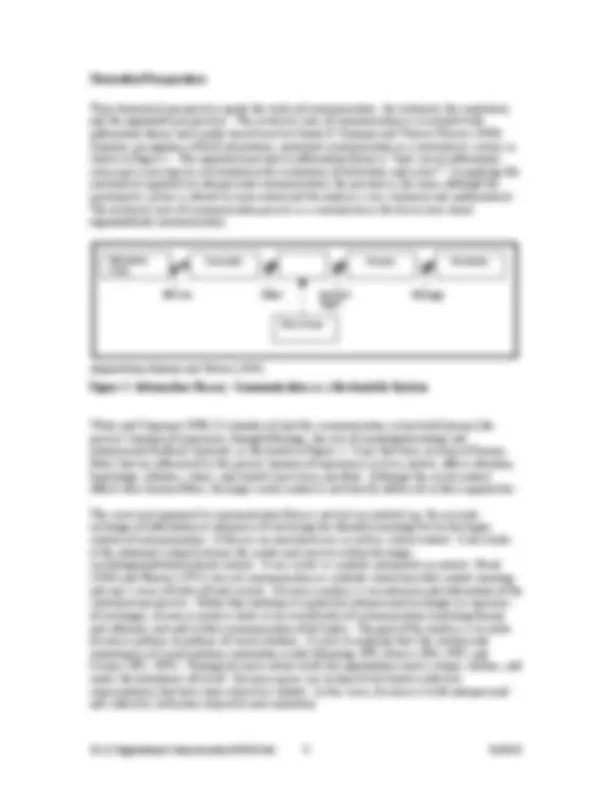
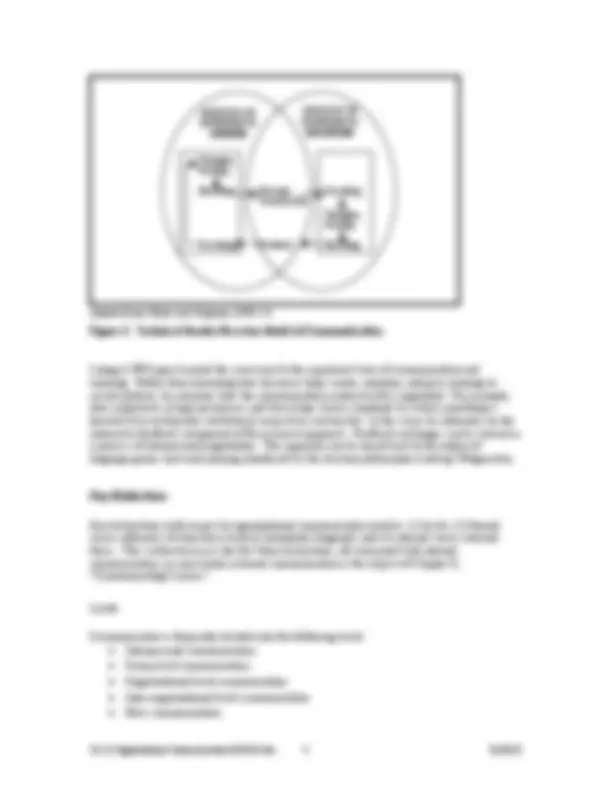
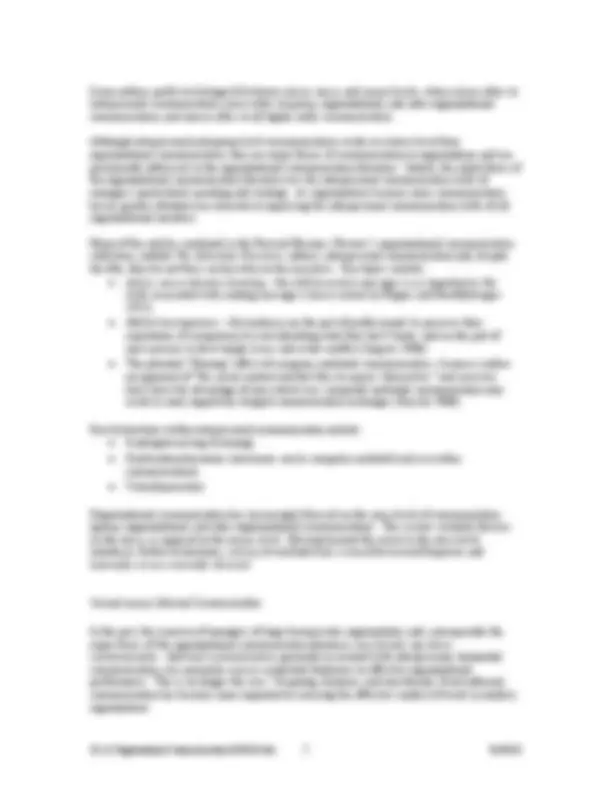
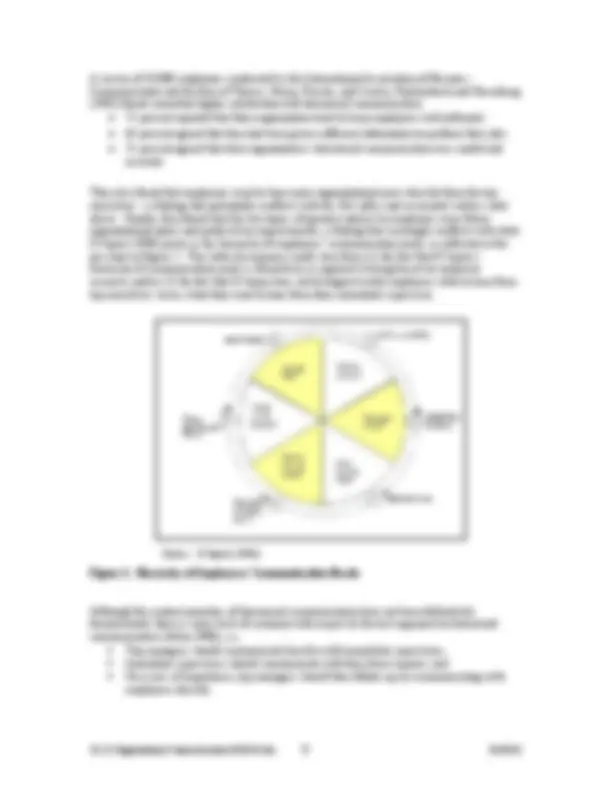
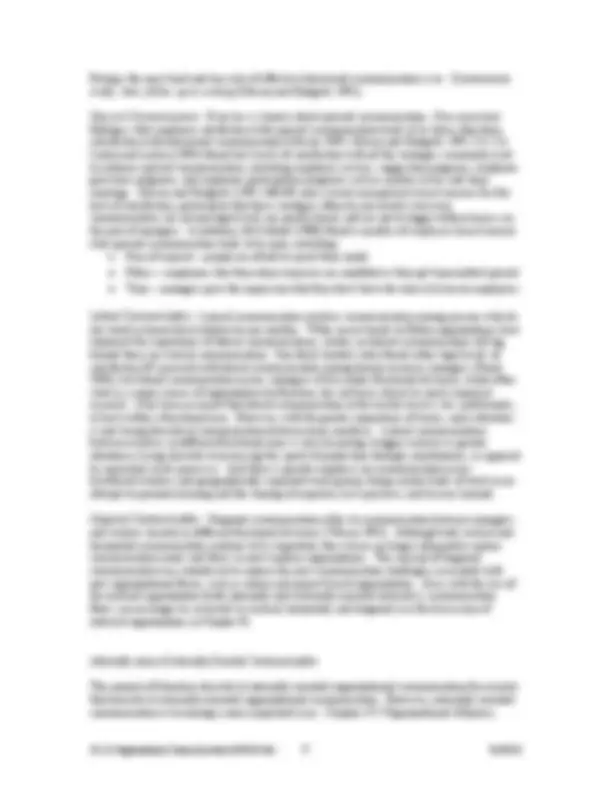
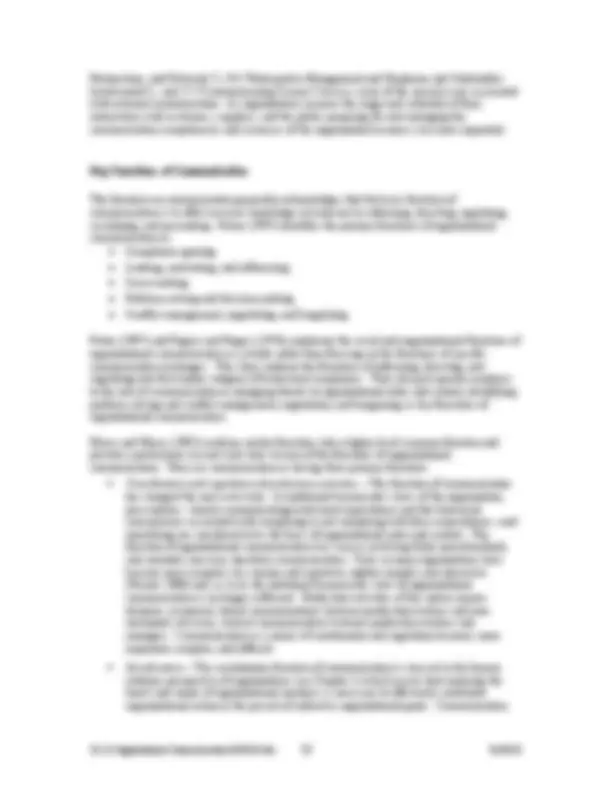
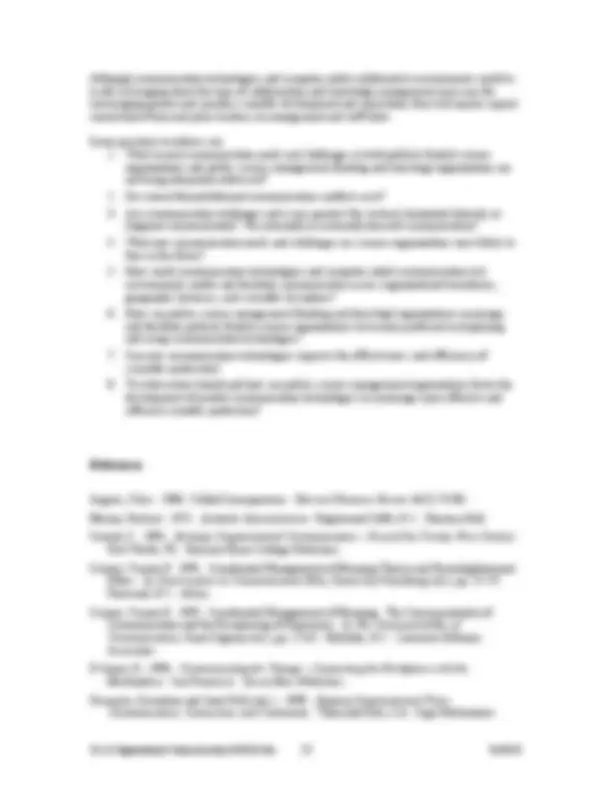
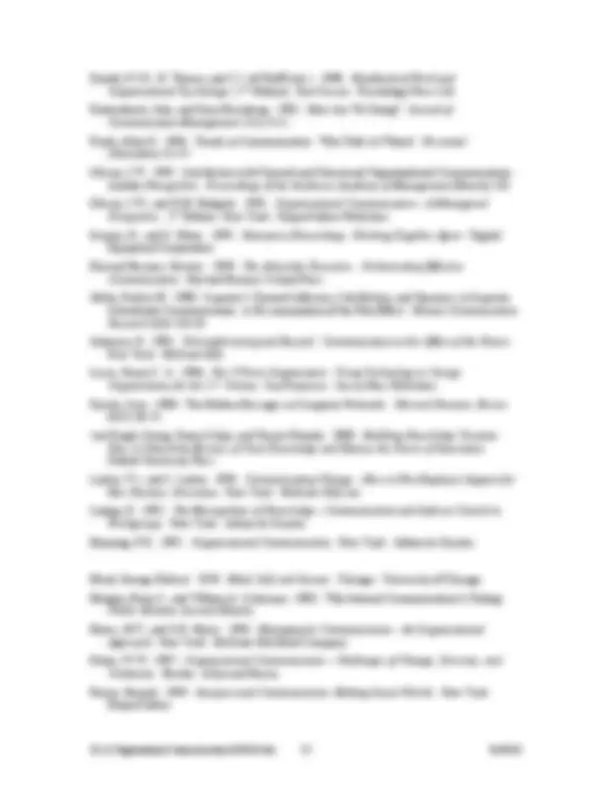



Study with the several resources on Docsity

Earn points by helping other students or get them with a premium plan


Prepare for your exams
Study with the several resources on Docsity

Earn points to download
Earn points by helping other students or get them with a premium plan
Community
Ask the community for help and clear up your study doubts
Discover the best universities in your country according to Docsity users
Free resources
Download our free guides on studying techniques, anxiety management strategies, and thesis advice from Docsity tutors
Management Benchmark Study-Book Summary Chapter 13-Literature-Elizabeth L. Malone Organizational Communication, Kathryn A. Baker , Information Theory, Sender-Receiver Model of Communication, Internally versus Externally Directed Communication
Typology: Summaries
1 / 15

This page cannot be seen from the preview
Don't miss anything!










Managers have traditionally spent the majority of their time communicating in one form or another (meetings, face-to-face discussions, memos, letters, e-mails, reports, etc.). Today, however, more and more employees find that an important part of their work is communication, especially now that service workers outnumber production workers and research as well as production processes emphasize greater collaboration and teamwork among workers in different functional groups. Moreover, a sea-change in communication technologies has contributed to the transformation of both work and organizational structure. For these reasons, communication practices and technologies have become more important in all organizations, but they are perhaps most important in knowledge-intensive organizations and sectors and, as such, are of great significance to science organizations and to public science management.
The study of organizational communication is not new, but it has only recently achieved some degree of recognition as a field of academic study. It has largely grown in response to the needs and concerns of business. The first communication programs were typically located in speech departments, but most business schools now include organizational communication as a key element of study. The study of organizational communication recognizes that communication in organizations goes far beyond training managers to be effective speakers and to have good interpersonal communication skills. Moreover, it recognizes that all organizations, not just business organizations, have communication needs and challenges.
The field of organizational communication is highly diverse and fragmented, as evidenced by results of literature searches on the topic, textbooks in the area, and the Harvard Business Review’s (1993) compilation of its communication articles, The Articulate Executive. It spans communication at the micro, meso, and macro levels; formal and informal communications; and internal organizational communication practices (newsletters, presentations, strategic communications, work direction, performance reviews, meetings) as well as externally directed communications (public, media, inter-organizational). Innovation, organizational learning, knowledge management, conflict management, diversity, and communication technologies are also addressed. As a new academic discipline, organizational communication is struggling to develop and convey some sense of coherency across these many areas.
In addition to its fragmented nature, organizational communication, perhaps more than any other aspect of organizational theory and practice, has been subject to dramatic change. Before 1920, communication in small organizations was largely informal. As organizations increased in size, formal top-down communication became the main concern of organizational managers. Organizational communication in today’s organizations has not only become far more complex and varied but more important to overall organizational functioning and success. While research used to focus on understanding how organizational communication varied by organizational type and structure, the emphasis has increasingly turned to understanding how new communication technologies and capabilities can help bring about new and more effective organizational forms and processes (Tucker et al. 1996; Desanctis and Fulk 1999).
(^1) Related chapters include: Change Management; Knowledge Management; Leadership; Organizational
Culture; Innovation.
This review summarizes the historical trends and the increasing importance of organizational communication, the basic theoretical perspectives that guide the study of communication and the key distinctions that guide the study of organizational communication, the key functions of communication in organizations, and implications of communication technologies for organizations. Because organizational communication has become such a big topic, this review is limited to addressing internal organizational communication. Interactions with external stakeholders and communication of scientific information to external audiences are addressed in separate chapters (see Chapter 10. “Participative Management and Chapter 17. “Communicating Science”).
Views of organizational communication can be categorized as those that view organizational communication as one aspect of an organization versus those that see it as the underlying basis of the organization itself. An example of the former is exemplified by Drenth et al. (1998), who define communication as the sending and receiving of messages by means of symbols and see organizational communication as a key element of organizational climate. The latter viewpoint is reflected by Myers and Myers (1982:xv) who define organizational communication as “the central binding force that permits coordination among people and thus allows for organized behavior,” and Rogers and Rogers (1976:3) who argue that “the behavior of individuals in organizations is best understood from a communication point of view.”
In many ways, organizations have evolved in directions that make the latter view more appropriate. Changes confronting organizations and the associated changes in organizational forms have made organizational communication increasingly important to overall organizational functioning. For example: ♦ Work is more complex and requires greater coordination and interaction among workers ♦ The pace of work is faster ♦ Workers are more distributed ♦ Simultaneous, distributed work processes are more common ♦ Knowledge and innovation are more critical to an organization’s competitive advantage ♦ Communication technologies and networks are increasingly essential to an organization’s structure and strategy.
Communication is not only an essential aspect of these recent organizational changes, but effective communication can be seen as the foundation of modern organizations (Grenier and Metes 1992; D’Aprix 1996; Witherspoon 1997; von Krogh et al. 2000).
Adapted from White and Chapman (1996:11)
Lazega (1992) goes beyond the contextual to the negotiated view of communication and meaning. Rather than examining how discourse helps create, maintain, and give meaning to social relations, he examines how the communication context itself is negotiated. For example, how judgements of appropriateness and knowledge claims (standards by which something is deemed to be technically satisfactory) come to be constructed. In this sense he elaborates on the interactive feedback component of the technical approach. Feedback exchanges can be viewed as a process of interpersonal negotiation. This approach can be traced back to the notion of language games and word playing introduced by the Austrian philosopher Ludwig Wittgenstein.
Key distinctions with respect to organizational communication involve: (1) levels; (2) formal versus informal; (3) direction (vertical, horizontal, diagonal); and (4) internal versus external focus. This section discusses the first three distinctions, all concerned with internal communication, in some detail; external communication is the subject of Chapter X, “Communicating Science.”
Communication is frequently divided into the following levels: ♦ Interpersonal communication ♦ Group level communication ♦ Organizational level communication ♦ Inter-organizational level communication ♦ Mass communication.
Thoughts, Feelings
Message Transmission
Decoding
HORIZON OF EXPERIENCE SENDER
HORIZON OF EXPERIENCE RECEIVER
Encoding
Decoding
Thoughts, Feelings
Feedback Encoding
Some authors prefer to distinguish between micro, meso, and macro levels, where micro refers to interpersonal communication; meso refers to group, organizational, and inter-organizational communication; and macro refers to all higher order communication.
Although interpersonal and group level communications reside at a lower level than organizational communication, they are major forms of communication in organizations and are prominently addressed in the organizational communication literature. Indeed, the initial focus of the organizational communication literature was the interpersonal communication skills of managers (particularly speaking and writing). As organizations became more communication- based, greater attention was directed at improving the interpersonal communication skills of all organizational members.
Many of the articles contained in the Harvard Business Review’s organizational communication collection, entitled The Articulate Executive , address interpersonal communication and, despite the title, they do not focus exclusively on the executive. Key topics include: ♦ Active, non-evaluative listening – the skill to receive messages is as important as the skills associated with sending messages (classic article by Rogers and Roethlisberger
♦ Skilled incompetence – the tendency on the part of professionals to preserve their reputations of competency by not admitting what they don’t know, and on the part of most persons to duck tough issues and avoid conflict (Argyris 1986) ♦ The potential “flaming” effect of computer-mediated communication – because senders are ignorant of “the social context and feel free to express themselves” and receivers don’t have the advantage of non-verbal cues computed-mediated communication may result in more negatively charged communication exchanges (Kiesler 1986).
Key distinctions within interpersonal communication include: ♦ Sending/receiving (listening) ♦ Oral/written/electronic (electronic can be computer mediated oral or written communication) ♦ Verbal/nonverbal.
Organizational communication has increasingly focused on the meso level of communication (group, organizational, and inter-organizational communication). This review similarly focuses on the meso, as opposed to the micro, level. Moving beyond the micro to the meso level introduces further distinctions, such as formal/informal , vertical/horizontal/diagonal , and internally versus externally directed.
In the past, the concern of managers of large bureaucratic organizations and, consequently the major focus of the organizational communication literature, was formal, top-down communication. Informal communication , generally associated with interpersonal, horizontal communication, was primarily seen as a potential hindrance to effective organizational performance. This is no longer the case. On-going, dynamic, and non-formal, if not informal, communication has become more important to ensuring the effective conduct of work in modern organizations.
0
5
10
15
20
25
30
35
40
Managers 40% Professionals 39%
Clericals 32% Hourly 26%
Communication can also be characterized as vertical, horizontal, or diagonal. Initially greater emphasis was directed at vertical organizational communication as compared to lateral communication but that is no longer the case. Diagonal communication is an even more recent emphasis in the organizational communication literature.
persons and can involve both downward and upward communication flows. Downward communication is more prevalent than upward communication. Larkin and Larkin (1994) suggest that downward communication is most effective if top managers communicate directly with immediate supervisors and immediate supervisors communicate with their staff. A wealth of evidence shows that increasing the power of immediate supervisors increases both satisfaction and performance among employees. This was first discovered by Donald Pelz (1952) and is commonly referred to as the Pelz effect. Pelz was attempting to find out what types of leadership styles led to employee satisfaction (informal/formal, autocratic/participative, management- oriented/frontline-oriented). He found that what matters most is not the supervisor’s leadership style but whether the supervisor has power. One way to give supervisors power is to communicate directly with them and to have them provide input to decisions. Ensuring that supervisors are informed about organizational issues/changes before staff in general, and then allowing them to communicate these issues/changes to their staff, helps reinforce their position of power. When the supervisor is perceived as having power, employees have greater trust in the supervisor, greater desire for communication with the supervisor, and are more likely to believe that the information coming from the supervisor is accurate (Roberts and O’Reilly 1974). Jablin (1980), after reviewing almost 30 years of research, pronounced the Pelz effect to be “one of the most widely accepted propositions about organizational communication.”
Downward Communication. Based on a survey of 30,000 employees conducted by the Opinion Research Corporation, Morgan and Schieman (1983) found that a majority of the workers felt their organization did not do a good job of downward communication. As seen in Figure 4, satisfaction levels were especially low at lower job levels.
Adapted from Morgan and Schieman (1983:16).
Percentage of Employees Rating Downward Communication as Good or Very Good
A survey of 32,000 employees conducted by the International Association of Business Communication and the firm of Towers, Perrin, Forster, and Crosby, Foehrenbach and Rosenberg (1982) found somewhat higher satisfaction with downward communication: ♦ 71 percent reported that their organization tried to keep employees well informed. ♦ 65 percent agreed that they had been given sufficient information to perform their jobs. ♦ 51 percent agreed that their organization’s downward communication was candid and accurate.
They also found that employees want to hear more organizational news directly from the top executives – a finding that potentially conflicts with the Pelz effect and associated studies cited above. Finally, they found that the two topics of greatest interest to employees were future organizational plans and productivity improvements, a finding that seemingly conflicts with what D’Aprix (1996) posits as the hierarchy of employees’ communication needs, as reflected in the pie chart in Figure 5. This latter discrepancy could stem from (1) the fact that D’Aprix’s hierarchy of communication needs is theoretical, as opposed to being based on empirical research, and/or (2) the fact that D’Aprix does not distinguish what employees what to hear from top executives versus what they want to hear from their immediate supervisor.
Source: D’Aprix (1996)
Although the content priorities of downward communication have not been definitively demonstrated, there is some level of certainty with respect to the best approach to downward communication (Jablin 1980), i.e.,
Partnerships, and Networks”), 10.(“Participative Management and Employee and Stakeholder Involvement”), and 17 (“Communicating Science”) discuss some of the special issues associated with external communication. As organizations increase the range and centrality of their interactions with customers, suppliers, and the public preparing for and managing the communication competencies and resources of the organization becomes ever more important.
The literature on communication generally acknowledges that the basic function of communication is to affect receiver knowledge or behavior by informing, directing, regulating, socializing, and persuading. Neher (1997) identifies the primary functions of organizational communication as: ♦ Compliance-gaining ♦ Leading, motivating, and influencing ♦ Sense-making ♦ Problem-solving and decision-making ♦ Conflict management, negotiating, and bargaining.
Neher (1997) and Rogers and Rogers (1976) emphasize the social and organizational functions of organizational communication as a whole rather than focusing on the functions of specific communication exchanges. Thus they combine the functions of informing, directing, and regulating into the broader category of behavioral compliance. They also give greater emphasis to the role of communication in managing threats to organizational order and control, identifying problem solving and conflict management, negotiation, and bargaining as key functions of organizational communication.
Myers and Myers (1982) combine similar functions into a higher level common function and provide a particularly succinct and clear version of the functions of organizational communication. They see communication as having three primary functions:
directed at socializing organizational members focuses on articulating and reinforcing organizational values and aligning individual goals with organizational goals. It is directed at establishing an appropriate organizational culture and climate. This form of communication cannot be one-way or top-down. It must occur reciprocally between organizational leaders and organizational members.
This approach focuses on the functional goals of organizational communication, rather than on the near-term outcomes of particular acts of communication, such as to make a decision, to persuade, or to resolve a conflict. The more specific functions of specific acts of communication or sets of communication exchange (decision-making, informing, persuading, negotiating, problem-solving) are subsumed into each of the three higher-level functional objectives.
There has been a sea-change in communication technologies and a corresponding sea-change in communication theory and research. The organizational communication literature traditionally focused on how variations in organizational communication were affected by variations in the size, structure, and types of organization and how different types of organizational cultures gave rise to different types of organizational communication. The literature has now switched the causal ordering, emphasizing how new forms of organizational communication can bring about new organizational structures, cultures, as well as wholly new organizational forms.
New communication technologies and possibilities, combined with new challenges confronting organizations, are encouraging a whole new approach to organizational communication that challenges the very nature of organizations themselves. Radically new communication-enabled organizational forms are possible and are now emerging (see Tucker et al. 1996, Lucas 1996, Desanctis and Fulk 1999). On a less grandiose scale, new communication technologies can enable almost every aspect of organizational management and effectiveness, including change management (Chapter 4), knowledge management (Chapter 5), participative management (Chapter 10), innovation (Chapter 14), and organizational partnerships and alliances (Chapter 9).
The most notable advances in communication technology are groupware or computer facilitated group communication technologies. Johansen (1984) distinguishes groupware in terms of temporal (synchronous/asynchronous) and spatial (distributed/co-located) contexts as shown in Figure 5. These communication technologies can help traditional organizational groups work together more effectively. But, more importantly, they help dispersed individuals work as a team. The development of collaboratories, designed to help dispersed scientists conduct collaborative research and development as if they were co-located in a laboratory, may be one of the most exciting applications of the new communication technologies and computer-enabled environments. By capitalizing on new communication technologies, an organization should be able to realize a competitive advantage in its performance and in the marketplace (Lucas 1996; Tucker et al. 1996; Desanctis and Fulk 1999).
Although communication technologies and computer-aided collaborative environments could be useful in bringing about the type of collaboration and knowledge management necessary for encouraging greater and speedier scientific development and innovation, they will require a great commitment from and place burdens on management and staff alike.
Some questions to address are:
Argyris, Chris. 1986. Skilled Incompetence. Harvard Business Review 64(5):74-80.
Blumer, Herbert. 1972. Symbolic Interactionism. Englewood Cliffs, N.J.: Prentice-Hall.
Conrad, C. 1994. Strategic Organizational Communication – Toward the Twenty-First Century. Fort Worth, TX: Harcourt Brace College Publishers.
Cronen, Vernon E. 1991. Coordinated Management of Meaning Theory and Postenlightenment Ethics. In Conversation on Communication Ethic, Karen Joy Greenberg (ed.), pp. 21-53. Norwood, N.J.: Ablex.
Cronen, Vernon E. 1995. Coordinated Management of Meaning: The Consequentiality of Communication and the Recapturing of Experience. In The Consequentiality of Communication , Stuart Sigman (ed.), pp. 17-65. Hillsdale, N.J.: Lawrence Erlbaum Associates.
D’Aprix, R. 1996. Communicating for Change – Connecting the Workplace with the Marketplace. San Francisco: Jossey-Bass Publishers.
Desanctis, Gerardine and Janet Fulk (eds.). 1999. Shaping Organizational Form: Communication, Connection, and Community. Thousand Oaks, CA: Sage Publications.
Drenth, P.J.D., H. Thierry, and C.J. deWolff (eds.). 1998. Handbook of Work and Organizational Psychology ( 2 nd^ Edition). East Sussex: Psychology Press Ltd.
Foehrenbach, Julie, and Karn Rosenberg. 1982. How Are We Doing? Journal of Communication Management 12(1):3-11.
Frank, Allan D. 1984. Trends in Communication: Who Talks to Whom? Personnel (December):41-47.
Gibson, J.W. 1985. Satisfaction with Upward and Downward Organizational Communications: Another Perspective. Proceedings of the Southwest Academy of Management (March):150.
Gibson, J.W., and R.M. Hodgetts. 1991. Organizational Communication – A Managerial Perspective. 2 nd^ Edition. New York: HarperCollins Publishers.
Grenier, R., and G. Metes. 1992. Enterprise Networking – Working Together Apart. Digital Equipment Corporation.
Harvard Business Review. 1993. The Articulate Executive: Orchestrating Effective Communication. Harvard Business School Press.
Jablin, Fredric M. 1980. Superior’s Upward Influence, Satisfaction, and Openness in Superior- Subordinate Communication: A Re-examination of the Pelz Effect. Human Communication Research 6(3):210-20.
Johansen, R. 1984. Teleconferencing and Beyond: Communication in the Office of the Future. New York: McGraw-Hill.
Lucas, Henry C. Jr. 1996_. The T-Form Organization: Using Technology to Design Organizations for the 21st_^ Century. San Francisco: Jossey-Bass Publishers.
Kiesler, Sara. 1986. The Hidden Messages in Computer Networks. Harvard Business Review 64(1):46-52.
von Krogh, Georg, Kazuo Ichijo, and Ikujiro Nonaka. 2000. Enabling Knowledge Creation: How to Unlock the Mystery of Tacit Knowledge and Release the Power of Innovation. Oxford University Press.
Larkin, T.J., and S. Larkin. 1994_. Communicating Change – How to Win Employee Support for New Business Directions_. New York: McGraw-Hill, Inc.
Lazega, E. 1992. The Micropolitics of Knowledge – Communication and Indirect Control in Workgroups. New York: Aldine de Gruyter.
Manning, P.K. 1992. Organizational Communication. New York: Aldine de Gruyter.
Mead, George Herbert. 1934_. Mind, Self, and Society_. Chicago: University of Chicago.
Morgan, Brian S., and William A. Schieman. 1983. Why Internal Communication Is Failing. Public Relation Journal (March).
Myers, M.T., and G.E. Myers. 1982. Managing by Communication – An Organizational Approach. New York: McGraw-Hill Book Company.
Neher, W.W. 1997. Organizational Communication – Challenges of Change, Diversity, and Continuity. Boston: Allyn and Bacon.
Pearce, Barnett. 1994. Interpersonal Communication: Making Social Worlds. New York: HarperCollins.